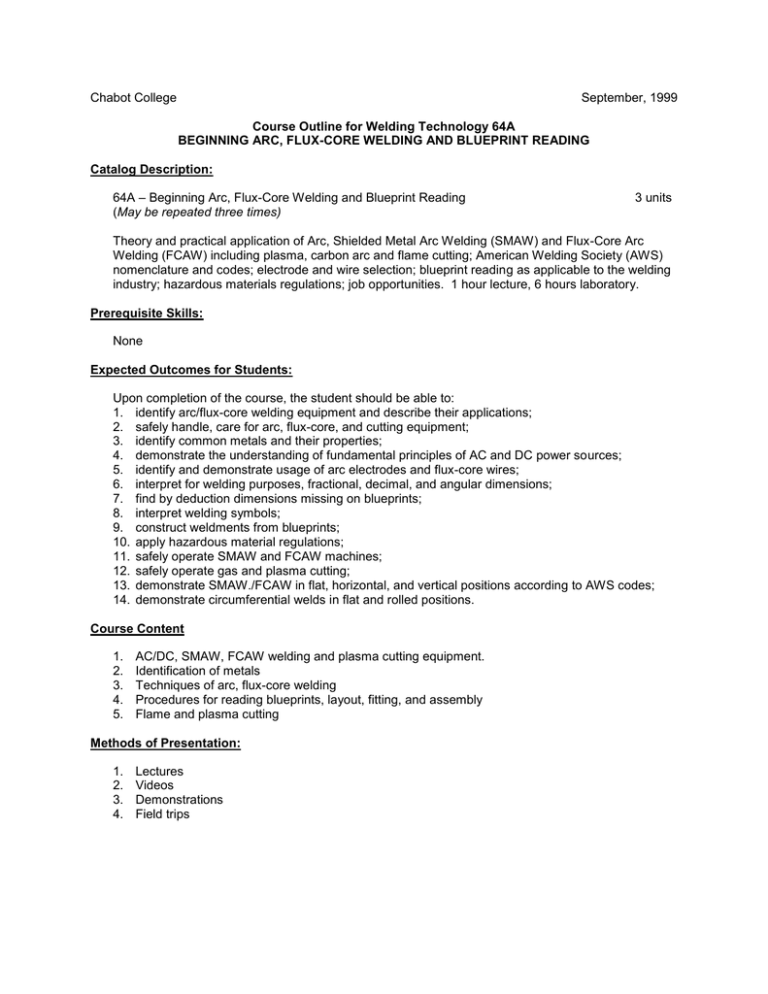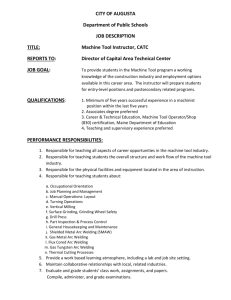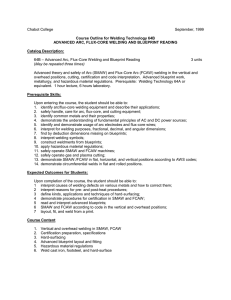Chabot College September, 1999 Course Outline for Welding Technology 64A
advertisement

Chabot College September, 1999 Course Outline for Welding Technology 64A BEGINNING ARC, FLUX-CORE WELDING AND BLUEPRINT READING Catalog Description: 64A – Beginning Arc, Flux-Core Welding and Blueprint Reading (May be repeated three times) 3 units Theory and practical application of Arc, Shielded Metal Arc Welding (SMAW) and Flux-Core Arc Welding (FCAW) including plasma, carbon arc and flame cutting; American Welding Society (AWS) nomenclature and codes; electrode and wire selection; blueprint reading as applicable to the welding industry; hazardous materials regulations; job opportunities. 1 hour lecture, 6 hours laboratory. Prerequisite Skills: None Expected Outcomes for Students: Upon completion of the course, the student should be able to: 1. identify arc/flux-core welding equipment and describe their applications; 2. safely handle, care for arc, flux-core, and cutting equipment; 3. identify common metals and their properties; 4. demonstrate the understanding of fundamental principles of AC and DC power sources; 5. identify and demonstrate usage of arc electrodes and flux-core wires; 6. interpret for welding purposes, fractional, decimal, and angular dimensions; 7. find by deduction dimensions missing on blueprints; 8. interpret welding symbols; 9. construct weldments from blueprints; 10. apply hazardous material regulations; 11. safely operate SMAW and FCAW machines; 12. safely operate gas and plasma cutting; 13. demonstrate SMAW./FCAW in flat, horizontal, and vertical positions according to AWS codes; 14. demonstrate circumferential welds in flat and rolled positions. Course Content 1. 2. 3. 4. 5. AC/DC, SMAW, FCAW welding and plasma cutting equipment. Identification of metals Techniques of arc, flux-core welding Procedures for reading blueprints, layout, fitting, and assembly Flame and plasma cutting Methods of Presentation: 1. 2. 3. 4. Lectures Videos Demonstrations Field trips Chabot College Course Outline for Welding Technology 64A, Page 2 September 1999 ] Assignments and Methods of Evaluating Student Progress: 1. Typical Assignments a. Lab Workbook Assignments b. Independent Welding Projects 2. Methods of Evaluating Student Progress a. Quizzes b. Examinations Textbook(s) (Typical): Welding Principles and Applications, 4th Edition, Larry Jeffus, Delmar, 1999 Special Student Materials: 1. 2. 3. 4. 5. 6. 7. Welders safety equipment Protective clothing Welders gloves Welders goggles Welders helmet Safety glasses Welding jacket and boots mc 2/01/00 COWT64A






